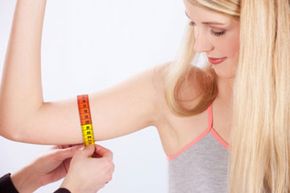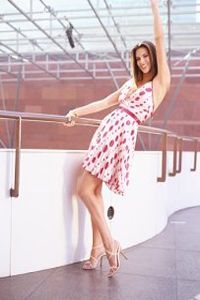If you've ever listened to TV fashion reporters critique actresses' attire on the red carpet, then you know how cringe-worthy it can be when a long-legged actress wears an empire waist that makes her look like a circus performer on stilts. Or when a starlet who's made too many visits to Häagen-Dazs squeezes herself into a little black dress and only half succeeds.
You definitely don't want to emulate such ill-conceived fashion catastrophes in your own wardrobe, and the good news is you don't have to. Even if you've got a less-than-perfect bod, you can still look eminently fabulous if you simply make a realistic assessment of your particular body type and then make choices that emphasize its most appealing qualities.
Advertisement
The most important rule of looking good, no matter what your shape, is not to be a slave to fashion. "Just because an article of clothing is in style doesn't mean that it belongs in your closet," warn style mavens Jill Martin and Pierre A. Lehu in their book, "Fashion for Dummies." Remember, haute couture designers live and work in a fantasy world in which all women are tall and have teeny waistlines but miraculously voluptuous busts and perfectly proportioned hips. Unless you're a laboratory clone of 1960s movie goddess Sophia Loren, you probably don't look like that.
Get Real
According to the Centers for Disease Control and Prevention, the average adult American woman is a shade under 5 foot 4 inches tall and weighs 164 pounds. Additionally, a 2005 North Carolina State University study of 6,000 American women found that only eight percent of them have the so-called hourglass shape for which most high-fashion attire is designed. Instead, about 46 percent of women have what researchers call a "rectangular" figure, with less than 9 inches difference between their waists and their curves. About 20 percent have a "spoon" figure, with hips at least 2 inches larger than their busts, and another 14 percent have an "inverted triangle" figure, with a bust that is 3 or more inches bigger than their hips.
Self-images can be woefully misleading, so the first thing you should do is take accurate measurements of your chest, waist and hips. That will help you determine which body type you are. Additionally, measure your inseam, sleeve length, arms and thighs. Those numbers will help you to evaluate whether a particular garment or designer will suit you.
Here are a few general tips for the most common variations of the female shape, based upon image consultant Jane Liddelow's Style Makeover HQ Web site:
Rectangular: You want to call attention to your top to divert eyes from your straight-up-and-down proportions. A little padding in your shoulders will do wonders, as long as you don't go overboard. If you have reasonably well-toned arms, go for sleeveless tops with a high neckline. Dresses that wrap or flow (meaning, they don't cinch) through the waistline are another good choice. When you wear slacks, go with straight or gently-flared hems. If you're slender, defining your waist with an artful belt can help, too.
Spoon: Wear flared slacks, jeans and skirts. That will help to balance the width of your hips. Tunic tops and jackets emphasize your torso rather than your bottom half. Another trick is to wear an off-the-shoulder top that emphasizes one or both shoulders.
Inverted Triangle: If you have broad shoulders or a particularly curvy bosom, you fall into this body shape category. First of all, if curves are your issue, spend some time picking out a bra that fits you, so that it doesn't further exaggerate your silhouette. Tops and dresses that flow through the waist are also good for evening out your proportions. Flared pants and A-line skirts will create the illusion of bodily balance, too.
Hourglass: Even though you're wonderfully symmetrical and you can pull off a wide variety of looks, you still need to pick clothes that at least subtly flatter your attributes. For example, stay away from baggy clothes that obscure your shape. Ditto for stiff fabrics and high necklines. You'll look your best in tailored, fitted clothes with soft fabrics, low to medium necklines, and gently-flared slacks and skirts.
Advertisement


